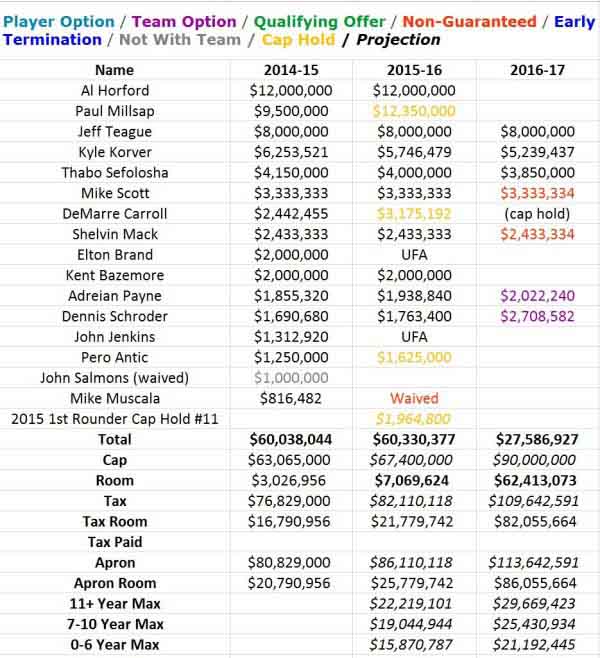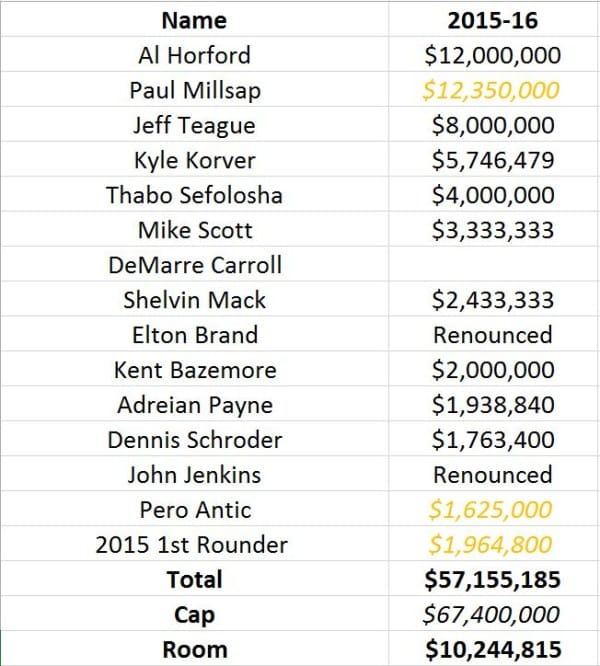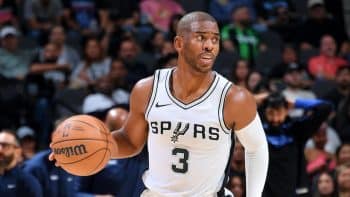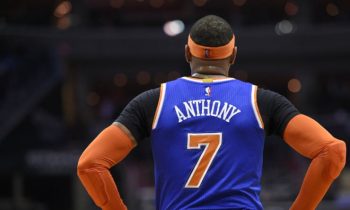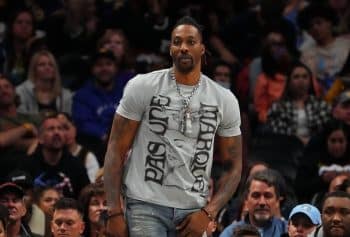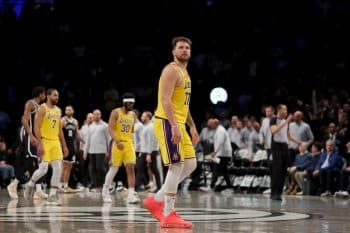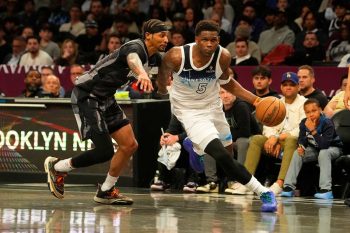NBA
Can the Atlanta Hawks Keep Their Team Together This Offseason?
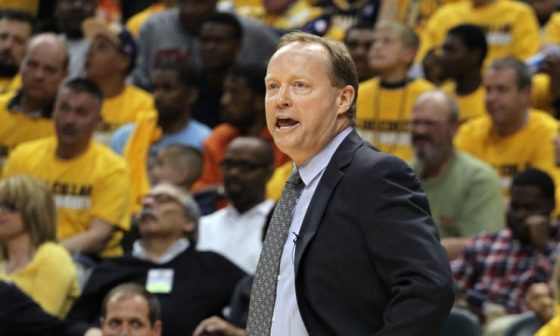
When word began to leak out about the NBA’s new television deal late on Sunday night, October 5, the focus immediately turned to the league’s free agent landscape. Cap dorks immediately began feverish calculations. The eventual conclusion is that the salary cap could rise to as much as $90 million for the 2016-17 season, when over $2 billion per season in TV money will line the league’s coffers. While reports have indicated that the NBA has engaged the players’ union in talks to “smooth” the impact of the new deal over successive seasons, it now appears that the players are unwilling to acquiesce to such a scenario. It now appears that the summer of 2016 will be a free agent free-for-all unmatched in league annals.
But for those who follow the league closely, contracts signed in the 2015 offseason could have nearly the same intrigue despite a comparatively modest projected increase from $63.065 million to $67.4 million. A number of converging factors make this summer absolutely fascinating. One, of course, is that looming 2016 offseason. Maximum contracts are delineated as a percentage of the salary cap at the time they are signed, but do not adjust upward based on a rising cap in subsequent seasons.* With the cap set to rise by almost a third in 2016, max contracts signed in 2015 could look relatively cheap in subsequent years.
Now consider that nearly half the league could have $15 million or more in cap room, with many others possessing a realistic possibility for a significant contract. While that is a lot of teams by historical norms, it pales in comparison to 2016, in which pretty much the entire league will have huge cap room. That year, the competition between teams along with the larger maximum contracts will result in a colossal feeding frenzy. Teams are no dummies–they realize they will likely get a lot more bang for their buck this offseason than the following year.
All of these factors could serve to inflate the 2015 market by quite a bit more over past years than the projected $4 million jump in the cap alone would indicate. And that could make this summer rather difficult for a current league darling, the Atlanta Hawks. Hawks GM in absentia Danny Ferry deserves plaudits for having built such a flexible and competitive roster. But the price of that flexibility is the 2015 free agency of two starters and a key reserve: Paul Millsap, DeMarre Carroll and Pero Antic.* All were wisely signed to two-year contracts in the Hawks’ landmark summer of 2013.* With Millsap 28, Carroll 27 and Antic 31, the Hawks were locking these players up through what were likely the best years they had left while avoiding overpaying for possible decline years. Now though, Atlanta must pay the price for those players outperforming their modest deals.**
**Atlanta would surely love to talk contract extension with all three to prevent their hitting the open market, but the 2011 CBA prohibits extensions on contracts any shorter than four years, while preventing raises of more than 107.5 percent from a player’s previous salary.
Here is what the Hawks’ 2015 offseason could look like, including cap holds for Millsap, Carroll and Antic.*
Under that scenario, they are currently projected to have over $9 million in cap space even with those three free agents’ cap holds. Add in a cap hold from their first-round pick, which will probably be about number 11 since it can be swapped with the Brooklyn Nets, and that drops to around $7 million. But due to the short-term contracts signed by Millsap and Carroll, that number is not as delicious as it might seem. Were they completing three-year deals, the Hawks could sign outside free agents up to the cap, then re-sign Millsap and Carroll for anything up to the maximum salary using the full Larry Bird exception, which allows teams to go over the cap to sign their own free agents. But since Millsap and Carroll have only been with the Hawks two years, Atlanta is limited to the Early Bird exception if they want to go over the cap to re-sign them. If Atlanta is over the cap when they re-sign them, that exception limits them to the higher of 175 percent of their prior salary or the Estimated Average Player Salary, likely around $5.7 million in 2015-16. They also may only offer a four-year deal, rather than five years if the players had full Bird rights.
Millsap is a particularly difficult case as a 30-year-old coming off consecutive All-Star appearances. He has bucked the aging trend for shorter power forwards, having his two best seasons at 28 and 29 by adding significantly to his skill level since his arrival in the A. His abilities to shoot threes, take bigger players to the basket on closeouts and post up effectively are essential to the Hawks’ beautiful offense. Defensively, he is highly underrated after garnering a reputation as a defensive liability playing next to Al Jefferson in Utah. All told, Millsap ranks 16th in ESPN’s Real Plus-Minus statistic, adding 5.07 points per 100 possession to the Hawks’ bottom line. His well-rounded game is especially rare as one of only five players in the league recording both an offensive and defensive RPM above 2.00.
Right now, it is clear Millsap is a premium player, although he likely benefits immensely from the spaced floor and ball movement of Coach Mike Budenholzer’s system. Nevertheless, if he keeps up this performance the rest of the year, he would likely be worth his individual maximum of around $19 million were we only considering next season. Unfortunately, the age-related decline Millsap has successfully postponed to date remains an issue for anything longer than a one-year deal, which free agents of his caliber rarely sign. So what is an appropriate deal with Millsap?
Remember that Marcin Gortat re-signed for a five-year, $60 million contract last offseason as a 30-year-old with a lower cap and less certainty about the influx of new TV money. While that may have been a bit of an overpay by the Wizards with the length of the contract,* it probably was not too far above market value. Millsap, of course, is a much better player than Gortat.
The most Millsap can glean via the Early Bird Exception is $16.6 million. If the Hawks were to offer him a four-year deal starting at that amount, it would be a very fair offer considering the likelihood of decline in the later years. Depending on the negotiations, the Hawks could possibly allow for a declining salary, opening up more room to add pieces in the upcoming years. This would result in a four-year deal totaling around $60 million. If Millsap demands a starting salary of more than $16.6 million, the Hawks would have to use cap space to sign him.
The timing and amount of his re-signing could also prove crucial due to the delicate situation with Carroll. Unless Millsap re-signs for a starting salary less than his $12.35 million cap hold (unlikely in this environment), the Hawks will want to delay his signing until after Carroll to allow them as much cap room as possible. And if Millsap signs for more than the Early Bird exception, it really limits what they can do with Carroll.
The Early Bird limitations could be problem in the case of Carroll, who is due a major raise from a bargain $2.4 million this year. He probably even deserves more than the $5.7 million Estimated Average Player Salary.* I previously sung Carroll’s praises as one of the league’s most underrated players, and selected him to my team of East All-Stars for a “real” All-Star game. He is now up to 40 percent on threes while shooting a robust 4.3 per game. But he also provides great cutting and energy offensively, leading to a high free throw rate for a secondary player and an overall .591 True Shooting Percentage. Those skills in concert with his abilities as a defender at both wing positions (so the Hawks can hide Kyle Korver) and smallball four (the latter of which the Hawks don’t really utilize) are a very rare combination. Of the other wings on the market this summer, only Danny Green and Khris Middleton offer the same combination of proven three-point shooting and defense.
Were he 27, Carroll could merit a four-year deal starting at eight figures per in this new environment. But at 29, a long-term deal is a little dicier. The Hawks might try one of two approaches. The first would be a four-year deal starting right at the Estimated Average Player Salary with the maximum 7.5 percent annual raises, totaling $25.4 million. While this may be a smaller starting salary than Carroll could get elsewhere, the number of years may be more than other teams would offer. Depending on the market dynamics, the Hawks could offer a player option on the fourth year. Keeping Carroll within the confines of the Early Bird exception could allow it to take advantage to add another two-way wing or big. Of course, this also assumes Carroll and Millsap were willing to wait to actually sign their deals until after Atlanta had used its cap space—a rather dicey situation that would require a lot of trust between the parties.
On the other hand, if Millsap and Carroll sign immediately, but are willing to stay within the Early Bird exceptions, the Hawks can stay over the cap and retain the $5.5 million Mid-Level Exception and the $2.1 million Bi-Annual Exception. This would certainly be their preferred route.
However, Carroll may find a deal within the confines of the Early Bird exception below his market value. In that case, the Hawks would like to look at offering him a shorter deal with higher salaries that decline in value throughout the length of the contract. The downside there is any deal starting at higher than the Early Bird Exception would require the use of their cap space. What’s more, by using cap space they would lose the MLE and BAE, limiting any further additions to the $2.8 million Room Exception. Nonetheless, the Hawks may have little choice. Including the first-round cap hold, the most the Hawks could pay Carroll is $10.2 million to start.
So a two-year deal around $21 million would be the idea. However, that would require Millsap waiting to sign until after Carroll, and staying within the Early Bird exception. If both Millsap and Carroll require salaries above the Early Bird Exception, the Hawks will have to look into jettisoning players like Thabo Sefolosha, Adreian Payne, Shelvin Mack, or Kent Bazemore. That would not be ideal, but none of those players are immovable.
It is also possible that the Hawks may find Carroll’s contract demands too expensive. In that case, they could have the space to look for his replacement(s). If Carroll signs elsewhere or is renounced, the Hawks could have that same $10.2 million to work with in a market that includes a fair number of wings. But that again would require the dicey plan of asking Millsap to wait to sign his new contract, and that the contract fit within the Early Bird exception.
Antic is a far simpler proposition due to what should be lower salary demands. The Macedonian is not a great individual player, but as a backup center who can shoot threes and avoid getting taken advantage of in the post he allows the Hawks to keep their style of play rolling with their bench units. At age 33 he probably will not get a ton of offers on the open market, so a two-year deal (the minimum allowed for an Early Bird contract) starting at around $2 million per year should get it done for him. As a restricted free agent, the Hawks have the right to match any outside offer.
Assuming the Hawks continue their dream season and reach at least the Conference Finals, retaining Millsap and Carroll should be their preferred approach. Adding another piece is possible via cap room or more likely the MLE, but depends on the amounts of their contracts and when they are signed. The more likely outcome is retaining Millsap and Carroll, then adding a minimal piece via the Room Exception. Even if that occurs, in 2016 Hawks could still have as much as $20 million in cap to add another free agent and still re-sign Al Horford. If they keep winning like this, Atlanta could prove a premium free agent destination for the first time in its history.
Team Rebounds:
- There are many good arguments for smoothing, laid out by Basketball Insiders’ and ESPN’s Larry Coon in this piece. As he notes, the players will be entitled to 51 percent of the revenue even if player contracts do not add up to that much–the owners would simply write the players checks to alleviate the shortfall. However, the players may get some perceived value out of getting as many big contracts as they can on the books prior to a likely CBA opt-out by one of the two sides in the summer of 2017. Smoothing is also something the owners want more than the players. It may just be good negotiating to avoid simply agreeing without other concessions from the NBA, which the league in turn may be unwilling to give up. On the other hand, cynics may also note that player agents would be against smoothing because they get a cut of new contracts, but do not get a cut of checks the league gives the players to cover any shortfall below 51 percent. What’s more, with the league’s two biggest stars set to be free agents in 2016, and LeBron James having specifically positioned himself to be so that year, they would not be too happy about their maximum salary for that year being reduced due to smoothing.
- It was noted earlier that contracts do not adjust upward with a rising cap. They are limited to 7.5 percent annual raises for a player re-signing via Early Bird or Bird rights (or extending with his prior team) and 4.5 percent annual raises when signing with another team or changing teams via sign-and-trade. The only exception is trade bonuses, which can encompass up to 15 percent of the remaining salary on the contract at the time the player is traded. Trade bonuses have usually been of little relevance for max players, since their built-in raises outstrip the growth in the cap, and a trade bonus cannot cause a player’s salary to exceed the overall maximum for his experience level. But with the cap going up like crazy after 2015, even max players will be able to get their full 15 percent trade bonuses in the event they are moved. Expect agents to push much harder for trade bonuses on max contracts than in the past–and to get them in this buyers’ market.
- As of this writing, the Warriors currently possess the fourth-best point differential in NBA history, behind only the 1995-96 Chicago Bulls, the 1970-71 Milwaukee Bucks and the 1971-72 Los Angeles Lakers. If the Warriors can keep this up all season (and win the championship, of course), their feat will be much more impressive than those predecessors’. Those teams all benefited from recent expansion to fatten up their victory margins. The NBA expanded by eight teams from the 1966-67 to 1970-71 season, nearly doubling the number of teams from nine to 17. The ABA’s 11 teams by 1970-71 siphoned away even more talent, meaning it was far easier for teams with a few dominant players to eviscerate the league as those Bucks and Lakers did. The Bulls’ 72 win season also came in an expansion year, a few years after the league added four more teams. Throw in terrible drafts from 1988 to 1991, and the league was much more watered down back then. With more talent from overseas, better training and player development, and perhaps most importantly much smarter front offices than in the past distributed throughout the league, winning in the NBA is harder today than it has ever been. That makes what the Warriors are doing all the more remarkable.
